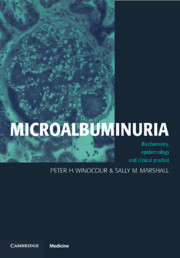Book contents
- Frontmatter
- Contents
- Preface
- Foreword by Professor K. G. M. M. Alberti
- 1 Renal structure and physiology
- 2 Measurement and expression of microalbuminuria
- 3 Epidemiology and determinants of microalbuminuria in health
- 4 Microalbuminuria in diabetes mellitus
- 5 Microalbuminuria as a marker of endothelial dysfunction
- 6 Microalbuminuria, cardiovascular risk factors and cardiovascular disease
- 7 Microalbuminuria as a non-specific marker of disease
- 8 The management of microalbuminuria in diabetes mellitus and essential hypertension
- Index
6 - Microalbuminuria, cardiovascular risk factors and cardiovascular disease
Published online by Cambridge University Press: 06 July 2010
- Frontmatter
- Contents
- Preface
- Foreword by Professor K. G. M. M. Alberti
- 1 Renal structure and physiology
- 2 Measurement and expression of microalbuminuria
- 3 Epidemiology and determinants of microalbuminuria in health
- 4 Microalbuminuria in diabetes mellitus
- 5 Microalbuminuria as a marker of endothelial dysfunction
- 6 Microalbuminuria, cardiovascular risk factors and cardiovascular disease
- 7 Microalbuminuria as a non-specific marker of disease
- 8 The management of microalbuminuria in diabetes mellitus and essential hypertension
- Index
Summary
The relationship between microalbuminuria and cardiovascular disease (CVD) was first noted in NIDDM, but has since been documented in IDDM and non-diabetic populations. The exact nature of the association is not fully resolved, but at least three major factors are of importance.
(1) The observation that microalbuminuria is often manifest in subjects who also have other features which, in their own right, put them at risk of atherosclerotic vascular disease.
(2) The attractive hypothesis that microalbuminuria reflects generalised loss of endothelial integrity, affecting not only glomerular capillaries, but also arterial and arteriolar intimal function, thereby promoting transvascular escape of atherogenic molecules.
(3) The suggestion that in many cases, microalbuminuria is simply the consequence of established cardiovascular disease.
These three concepts are by no means mutually exclusive, and together may well explain why the development of microalbuminuria carries such a poor long-term prognosis. The hypothesis that microalbuminuria is a marker of generalised endothelial dysfunction has already been discussed in Chapter 5.
The present chapter will focus on the interaction between microalbuminuria, cardiovascular risk factors, and atherosclerotic and non-atherosclerotic cardiovascular disease. These will be discussed in diabetic and non-diabetic subjects. One important practical point is that microalbuminuria and several other vascular risk factors often cluster within individuals, more particularly amongst those with diabetes mellitus. This pattern magnifies considerably the likelihood of cardiovascular morbidity and mortality, even though the absolute levels of the various factors are often only modestly disturbed.
- Type
- Chapter
- Information
- MicroalbuminuriaBiochemistry, Epidemiology and Clinical Practice, pp. 116 - 176Publisher: Cambridge University PressPrint publication year: 1998



